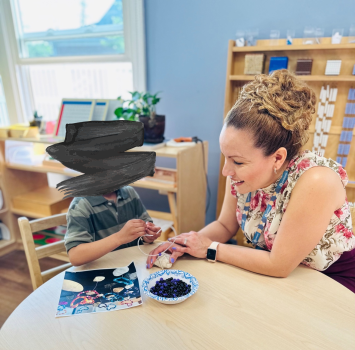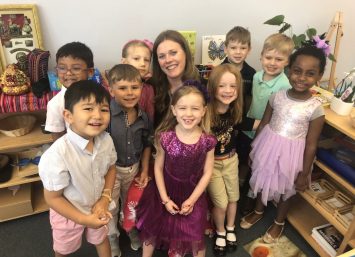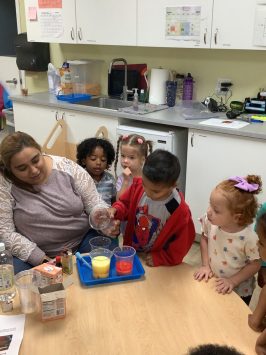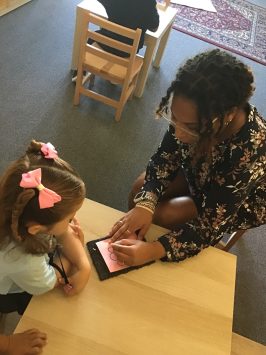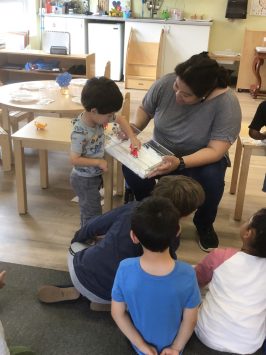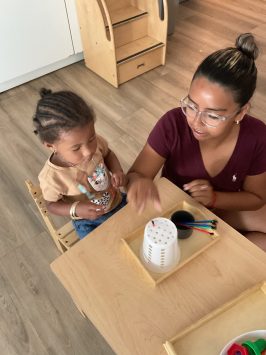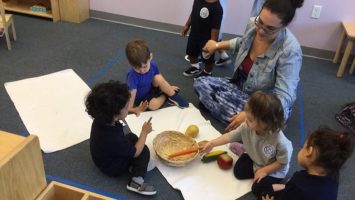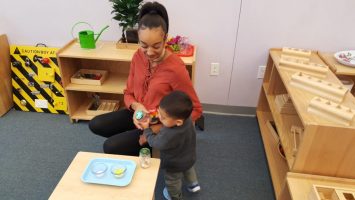Children’s House
Ages 3 years – 6 years
 Our Children’s House has two classrooms that provide authentic Montessori education in a balanced mixed age group that aims to help children gain independence, self-discipline, confidence, curiosity and problem solving competencies. Lessons are given in accordance with the teaching philosophy developed by Maria Montessori and provide children with activities that help them grow socially, emotionally, physically and intellectually.
Our Children’s House has two classrooms that provide authentic Montessori education in a balanced mixed age group that aims to help children gain independence, self-discipline, confidence, curiosity and problem solving competencies. Lessons are given in accordance with the teaching philosophy developed by Maria Montessori and provide children with activities that help them grow socially, emotionally, physically and intellectually.
The Children’s House functions on the traditional Montessori Three Year Cycle and culminates with the Kindergarten year. Students enrolled in our Children’s House can expect to engage in the following Montessori lessons and activities:
Practical Life: The classroom is the child’s living room and the activities in the Practical Life section are designed to help students learn to care for themselves, care for others and care for their environment. The lessons, through repetition, foster order, concentration, fine and gross motor skills, and help children become contributing members of their classroom community. Many of these activities, such as polishing, dusting, pouring, scooping, washing, etc. are recognizable to the children providing them a comfortable place to begin their exploration of the classroom. Typically, the goals of the Practical Life lessons are realized quickly thus encouraging children to attempt less familiar challenges. Practical Life remains integral through the Kindergarten year when children will accomplish sewing, embroidery, shoe tying and other necessary life skills.
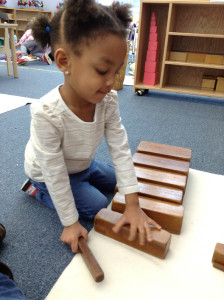
Sensorial: As the heart of the Montessori classroom, the majority of the sensorial materials were designed by Maria Montessori. These materials isolate the child’s individual senses to promote refined discrimination and classification. Children will smell, taste, feel, look and listen while assigning vocabulary and learning to differentiate at more acute levels. For example, smooth vs. rough will be fleshed out to order smooth, smoother, smoothest and rough, rougher, roughest. Ultimately, children build spatial relationships, recognize and create patterns, assemble and disassemble, all while indirectly building the basic skills they will need for advanced academic work in both the language and mathematical areas.
Language: The average child learns 14,000 words between birth and age six. Therefore, the language section is crucial to a child’s early childhood education. From the moment, a child enters the Children’s House classroom they are working towards the exciting goal of independent reading. Reading is taught phonetically and includes hands on experiences that help children learn sounds, form letters, recognize sight words, learn the parts of speech and ultimately builds to the full scope of reading that includes deconstructing and constructing words, reading comprehension, as well as writing with illustration.
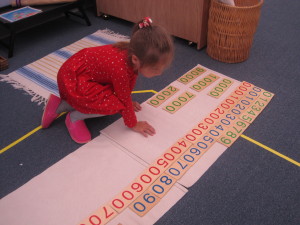 Mathematics: Students in the Children’s House classroom are provided hands on mathematical experiences that provide children with a concrete experience of quantity and mathematical operations. Children work towards abstraction and upon completion of the Kindergarten year are typically able to perform operations in their heads and often their mathematical work includes carrying and borrowing as well as more advanced concepts such as multiplication, division and fractions. Children also practice introductory geometry and even algebra.
Mathematics: Students in the Children’s House classroom are provided hands on mathematical experiences that provide children with a concrete experience of quantity and mathematical operations. Children work towards abstraction and upon completion of the Kindergarten year are typically able to perform operations in their heads and often their mathematical work includes carrying and borrowing as well as more advanced concepts such as multiplication, division and fractions. Children also practice introductory geometry and even algebra.
Science: Children are curious and the backbone of curiosity is experimentation. Our Children’s House students are introduced to various scientific concepts and disciplines such as magnetism, buoyancy, color mixing, zoology, botany, astronomy, and chemistry. The Montessori science activities encourage prediction, evaluation, experimentation, measurement and reporting. Additionally, children learn classification and proper nomenclature. Children are always encouraged to explore and discover.
Geography and Culture: Our children live in a global, connected and diverse world. For over 100 years, Montessori education has encouraged the study of and exposure to different cultural traditions, beliefs and customs. Children’s House students study the world closely 
beginning with the globe and moving locally as they progress. Families are encouraged to share their cultural and ethnic traditions. Our students celebrate many holidays and festivals experiencing cultural food, dances, clothing, goods, and beliefs with the aim of appreciating our difference and recognizing our oneness.
Peace Education: Maria Montessori was nominated for the Nobel Peace Prize three times and it is no wonder because peace is at the heart of her teaching philosophy as she believed man’s chances for peace start with the children. Now, more than ever children need to learn appropriate social and emotional skills. Our Children’s House classrooms always teach and promote, self-control, independence, empathy, reflection, appreciation, adaptability, emotional self-awareness, and positivity. Children are encouraged to self-discipline through inner motivation as opposed to systems of rewards and punishments.
Creativity and Expression: Our Children’s House classrooms encourage creativity and positive self-expression at all times. Art projects as well as free art activities such as painting, coloring, molding etc. are always readily available in the classroom. Additionally, many traditional Montessori activities incorporate elements of art and creativity. Students are exposed to music through dance, singing and simple listening enjoyment throughout the day. Furthermore, times for movement to encourage balance, coordination and control of body are integrated throughout the day.

